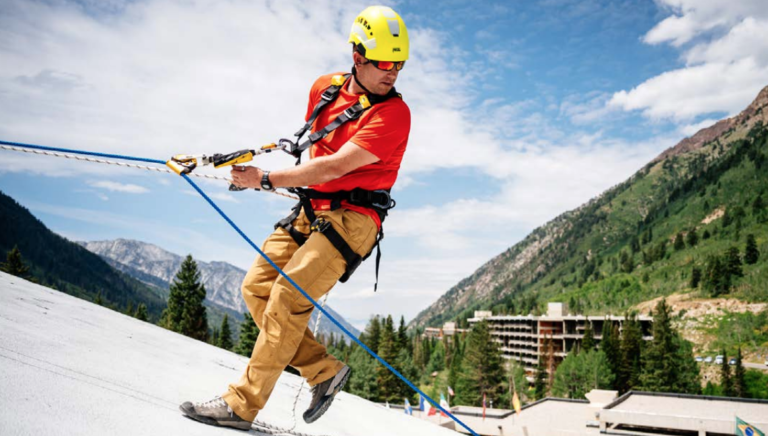HOW TO USE THE ASAP LOCK ON A VERTICAL LIFELINE IN A SLOPED ROOF APPLICATION Nate Williams, Petzl Technical Institute (PTI) Trainer in Petzl America, shows us how to use properly the ASAP LOCK on a vertical life system used in a sloped roof application, as it could be found while installing solar panels, doing roof inspection or conducting snow removal for instance.
Hello, I’m Nate with the Petzl Technical Institute. In this video, we’re going to look at the proper use of the ASAP Lock Vertical Lifeline System used in a slope roof application. Workers might find themselves working on a slope roof when doing things like installing solar panels, doing roof inspections, or since I’m at a ski resort, conducting snow removal.
Here at this resort work site, I’m going to access my slope roof using this portable ladder. I’m wearing a Newton full-body harness, and I’ll be connecting to the Ray 11-millimeter rope using the ASAP Lock and ASAP’SORBER 20. Each of the components in this fall arrest system are compliant to ANSI for workers’ weight up to 310 pounds.
Before I get started, I’m going to provide a little bit of weight to the bottom of my vertical lifeline. This is just going to facilitate upward travel of the ASAP wall climbing. Before leaving the ground, I’m going to install the ASAP onto the ray rope, and I’m going to do a quick function check to make sure that I’ve installed it properly and that it’s functioning. Next, I need to attach it to an appropriate fall arrest attachment point on my harness. Here I’m going to clip to my sternal attachment point. Some regulations such as OSHA in the US only allow for sternal attachments when the worker can limit the free fall distance to two feet or less. Regardless, it’s always important to keep your fall arrester in a high position to limit free fall distances.
All right. Now that we’re up here on the roof, we can see that it is low angle enough that I can stand comfortably and I don’t have to use the support of my harness. However, the exposed edge and the potential free fall hazard require me to use a fall arrest system. The great thing about using the ASAP Lock in my vertical lifeline is it allows me to move freely up and down the rope without any intervention. However, if I do need to work for an extended period of time, I can lock the ASAP Lock and place it in a high position while I do my work. This will limit my free fall potential.
Click Below For... Petzl ASAP Lock Complete Petzl ASAP Systems and Kits
The great thing about the ASAP Lock is that the locking mechanism is internal to the locking wheel. This means that the device will still lock, even if I grab it. The device works based on acceleration. Therefore, on this low-angle sloped roof, a falling worker may have a very slow acceleration. So it’s best practice to place a stop or not just above the unprotected edge of the roof to help prevent the falling worker from falling over the edge of the roof and being suspended in midair.
Additionally, the ASAP Lock Vertical Lifeline cannot serve as a positioning system. Now, I’m wearing the Petzl Avao Harness, which allows for a work positioning attachment, as well as a fall arrest attachment. So if the angle of the roof that I’m working on is steep enough that I need the support of my harness, I must use an independent positioning system such as the Petzl Grillon, as well as a fall arrest system.
All right. Once I’m finished working, I want to make sure my ASAP is unlocked. I can make my way to my stop or not above the unprotected edge and remove my knot, and make my egress down the portable ladder.
Peace on your Days
Lance









